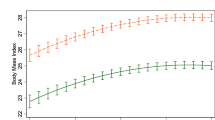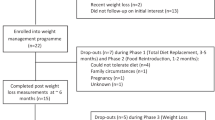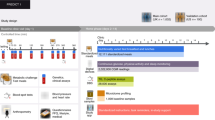Abstract
Background:
The postprandial responses in (an)orexigenic hormones and feelings of hunger are characterized by large inter-individual differences. Food intake regulation was shown earlier to be partly under genetic control.
Objective:
This study aimed to determine whether the postprandial responses in (an)orexigenic hormones and parameters of food intake regulation are associated with single nucleotide polymorphisms (SNPs) in genes encoding for satiety hormones and their receptors.
Design:
Peptide YY (PYY), glucagon-like peptide 1 and ghrelin levels, as well as feelings of hunger and satiety, were determined pre- and postprandially in 62 women and 41 men (age 31±14 years; body mass index 25.0±3.1 kg/m2). Dietary restraint, disinhibition and perceived hunger were determined using the three-factor eating questionnaire. SNPs were determined in the GHRL, GHSR, LEP, LEPR, PYY, NPY, NPY2R and CART genes.
Results:
The postprandial response in plasma ghrelin levels was associated with SNPs in PYY (215G>C, P<0.01) and LEPR (326A>G and 688A>G, P<0.01), and in plasma PYY levels with SNPs in GHRL (−501A>C, P<0.05) and GHSR (477G>A, P<0.05). The postprandial response in feelings of hunger was characterized by an SNP–SNP interaction involving SNPs in LEPR and NPY2R (668A>G and 585T>C, P<0.05). Dietary restraint and disinhibition were associated with an SNP in GHSR (477G>A, P<0.05), and perceived hunger with SNPs in GHSR and NPY (477G>A and 204T>C, P<0.05).
Conclusions:
Part of the inter-individual variability in postprandial responses in (an)orexigenic hormones can be explained by genetic variation. These postprandial responses represent either long-term physiological adaptations to facilitate homeostasis or reinforce direct genetic effects.
This is a preview of subscription content, access via your institution
Access options
Subscribe to this journal
Receive 12 print issues and online access
$259.00 per year
only $21.58 per issue
Buy this article
- Purchase on Springer Link
- Instant access to full article PDF
Prices may be subject to local taxes which are calculated during checkout



Similar content being viewed by others
References
Flier JS, Harris M, Hollenberg AN . Leptin, nutrition, and the thyroid: the why, the wherefore, and the wiring. J Clin Invest 2000; 105: 859–861.
Kristensen P, Judge ME, Thim L, Ribel U, Christjansen KN, Wulff BS et al. Hypothalamic CART is a new anorectic peptide regulated by leptin. Nature 1998; 393: 72–76.
Ebihara K, Ogawa Y, Katsuura G, Numata Y, Masuzaki H, Satoh N et al. Involvement of agouti-related protein, an endogenous antagonist of hypothalamic melanocortin receptor, in leptin action. Diabetes 1999; 48: 2028–2033.
Mizuno TM, Mobbs CV . Hypothalamic agouti-related protein messenger ribonucleic acid is inhibited by leptin and stimulated by fasting. Endocrinology 1999; 140: 814–817.
Anini Y, Brubaker PL . Role of leptin in the regulation of glucagon-like peptide-1 secretion. Diabetes 2003; 52: 252–259.
Drucker DJ . Glucagon-like peptides. Diabetes 1998; 47: 159–169.
Batterham RL, Cohen MA, Ellis SM, Le Roux CW, Withers DJ, Frost GS et al. Inhibition of food intake in obese subjects by peptide YY3-36. N Engl J Med 2003; 349: 941–948.
McGowan BM, Bloom SR . Peptide YY and appetite control. Curr Opin Pharmacol 2004; 4: 583–588.
Tovar SA, Seoane LM, Caminos JE, Nogueiras R, Casanueva FF, Dieguez C . Regulation of peptide YY levels by age, hormonal, and nutritional status. Obes Res 2004; 12: 1944–1950.
Chen HY, Trumbauer ME, Chen AS, Weingarth DT, Adams JR, Frazier EG et al. Orexigenic action of peripheral ghrelin is mediated by neuropeptide Y and agouti-related protein. Endocrinology 2004; 145: 2607–2612.
Kamegai J, Tamura H, Shimizu T, Ishii S, Sugihara H, Wakabayashi I . Chronic central infusion of ghrelin increases hypothalamic neuropeptide Y and Agouti-related protein mRNA levels and body weight in rats. Diabetes 2001; 50: 2438–2443.
Hoffstedt J, Eriksson P, Mottagui-Tabar S, Arner P . A polymorphism in the leptin promoter region (−2548 G/A) influences gene expression and adipose tissue secretion of leptin. Horm Metab Res 2002; 34: 355–359.
Mammes O, Betoulle D, Aubert R, Herbeth B, Siest G, Fumeron F . Association of the G-2548A polymorphism in the 5′ region of the LEP gene with overweight. Ann Hum Genet 2000; 64: 391–394.
Yiannakouris N, Yannakoulia M, Melistas L, Chan JL, Klimis-Zacas D, Mantzoros CS . The Q223R polymorphism of the leptin receptor gene is significantly associated with obesity and predicts a small percentage of body weight and body composition variability. J Clin Endocrinol Metab 2001; 86: 4434–4439.
Ahituv N, Kavaslar N, Schackwitz W, Ustaszewska A, Collier JM, Hebert S et al. A PYY Q62P variant linked to human obesity. Hum Mol Genet 2006; 15: 387–391.
Vartiainen J, Kesaniemi YA, Ukkola O . Sequencing analysis of ghrelin gene 5′ flanking region: relations between the sequence variants, fasting plasma total ghrelin concentrations, and body mass index. Metabolism 2006; 55: 1420–1425.
De Castro JM, Lilenfeld LR . Influence of heredity on dietary restraint, disinhibition, and perceived hunger in humans. Nutrition 2005; 21: 446–455.
Steinle NI, Hsueh WC, Snitker S, Pollin TI, Sakul H, St Jean PL et al. Eating behavior in the Old Order Amish: heritability analysis and a genome-wide linkage analysis. Am J Clin Nutr 2002; 75: 1098–1106.
Tholin S, Rasmussen F, Tynelius P, Karlsson J . Genetic and environmental influences on eating behavior: the Swedish Young Male Twins Study. Am J Clin Nutr 2005; 81: 564–569.
Diepvens K, Haberer D, Westerterp-Plantenga MS . Different proteins and biopeptides differently affect satiety and anorexigenic/orexigenic hormones in healthy humans. Int J Obes (Lond) 2008; 32: 510–518.
Batterham RL, Heffron H, Kapoor S, Chivers JE, Chandarana K, Herzog H et al. Critical role for peptide YY in protein-mediated satiation and body-weight regulation. Cell Metab 2006; 4: 223–233.
Makovey J, Naganathan V, Seibel M, Sambrook P . Gender differences in plasma ghrelin and its relations to body composition and bone—an opposite-sex twin study. Clin Endocrinol (Oxf) 2007; 66: 530–537.
Harris JAB, Benedict F . A Biometric Study of Basal Metabolism in Man. Carnegie institution of Washington: Washington, DC, 1919, publication no. 279.
Smeets AJ, Soenen S, Luscombe-Marsh ND, Ueland O, Westerterp-Plantenga MS . Energy expenditure, satiety, and plasma ghrelin, glucagon-like peptide 1, and peptide tyrosine-tyrosine concentrations following a single high-protein lunch. J Nutr 2008; 138: 698–702.
Stunkard AJ, Messick S . The three-factor eating questionnaire to measure dietary restraint, disinhibition and hunger. J Psychosom Res 1985; 29: 71–83.
Heidema AG, Boer JM, Nagelkerke N, Mariman EC, van der AD, Feskens EJ . The challenge for genetic epidemiologists: how to analyze large numbers of SNPs in relation to complex diseases. BMC Genet 2006; 7: 23.
Moore JH . Computational analysis of gene–gene interactions using multifactor dimensionality reduction. Expert Rev Mol Diagn 2004; 4: 795–803.
Ritchie MD, Hahn LW, Roodi N, Bailey LR, Dupont WD, Parl FF et al. Multifactor-dimensionality reduction reveals high-order interactions among estrogen-metabolism genes in sporadic breast cancer. Am J Hum Genet 2001; 69: 138–147.
Heidema AG, Feskens EJ, Doevendans PA, Ruven HJ, van Houwelingen HC, Mariman EC et al. Analysis of multiple SNPs in genetic association studies: comparison of three multi-locus methods to prioritize and select SNPs. Genet Epidemiol 2007; 31: 910–921.
Cummings DE, Purnell JQ, Frayo RS, Schmidova K, Wisse BE, Weigle DS . A preprandial rise in plasma ghrelin levels suggests a role in meal initiation in humans. Diabetes 2001; 50: 1714–1719.
Wren AM, Seal LJ, Cohen MA, Brynes AE, Frost GS, Murphy KG et al. Ghrelin enhances appetite and increases food intake in humans. J Clin Endocrinol Metab 2001; 86: 5992.
Chagnon YC, Chung WK, Perusse L, Chagnon M, Leibel RL, Bouchard C . Linkages and associations between the leptin receptor (LEPR) gene and human body composition in the Quebec Family Study. Int J Obes Relat Metab Disord 1999; 23: 278–286.
Clement K, Vaisse C, Lahlou N, Cabrol S, Pelloux V, Cassuto D et al. A mutation in the human leptin receptor gene causes obesity and pituitary dysfunction. Nature 1998; 392: 398–401.
Lahlou N, Clement K, Carel JC, Vaisse C, Lotton C, Le Bihan Y et al. Soluble leptin receptor in serum of subjects with complete resistance to leptin: relation to fat mass. Diabetes 2000; 49: 1347–1352.
Chagnon YC, Wilmore JH, Borecki IB, Gagnon J, Perusse L, Chagnon M et al. Associations between the leptin receptor gene and adiposity in middle-aged Caucasian males from the HERITAGE family study. J Clin Endocrinol Metab 2000; 85: 29–34.
Mattevi VS, Zembrzuski VM, Hutz MH . Association analysis of genes involved in the leptin-signaling pathway with obesity in Brazil. Int J Obes Relat Metab Disord 2002; 26: 1179–1185.
Gotoda T, Manning BS, Goldstone AP, Imrie H, Evans AL, Strosberg AD et al. Leptin receptor gene variation and obesity: lack of association in a white British male population. Hum Mol Genet 1997; 6: 869–876.
Rosmond R, Chagnon YC, Holm G, Chagnon M, Perusse L, Lindell K et al. Hypertension in obesity and the leptin receptor gene locus. J Clin Endocrinol Metab 2000; 85: 3126–3131.
Wauters M, Mertens I, Chagnon M, Rankinen T, Considine RV, Chagnon YC et al. Polymorphisms in the leptin receptor gene, body composition and fat distribution in overweight and obese women. Int J Obes Relat Metab Disord 2001; 25: 714–720.
Baessler A, Hasinoff MJ, Fischer M, Reinhard W, Sonnenberg GE, Olivier M et al. Genetic linkage and association of the growth hormone secretagogue receptor (ghrelin receptor) gene in human obesity. Diabetes 2005; 54: 259–267.
Laessle RG, Tuschl RJ, Kotthaus BC, Pirke KM . Behavioral and biological correlates of dietary restraint in normal life. Appetite 1989; 12: 83–94.
Tuschl RJ, Platte P, Laessle RG, Stichler W, Pirke KM . Energy expenditure and everyday eating behavior in healthy young women. Am J Clin Nutr 1990; 52: 81–86.
Vogels N, Mariman ECM, Bouwman FG, Diepvens K, Westerterp-Plantenga MS . Relationship of weight maintenance and dietary restraint with PPARgamma2, GRL and CNTF polymorphisms. Am J Clin Nutr 2005; 82: 740–746.
Vogels N, Westerterp-Plantenga MS . Categorical strategies based on subject characteristics of dietary restraint and physical activity, for weight maintenance. Int J Obes Relat Metab Disord 2005; 29: 849–857.
Torekov SS, Larsen LH, Glumer C, Borch-Johnsen K, Jorgensen T, Holst JJ et al. Evidence of an association between the Arg72 allele of the peptide YY and increased risk of type 2 diabetes. Diabetes 2005; 54: 2261–2265.
Lavebratt C, Alpman A, Persson B, Arner P, Hoffstedt J . Common neuropeptide Y2 receptor gene variant is protective against obesity among Swedish men. Int J Obes (Lond) 2006; 30: 453–459.
Acknowledgements
We thank Kristel Diepvens, Manuela Lejeune and Ananda Hochstenbach-Waelen for their contributions in acquiring the data on postprandial responses in (an)orexigenic hormones and feelings of hunger and satiety.
Author information
Authors and Affiliations
Corresponding author
Rights and permissions
About this article
Cite this article
den Hoed, M., Smeets, A., Veldhorst, M. et al. SNP analyses of postprandial responses in (an)orexigenic hormones and feelings of hunger reveal long-term physiological adaptations to facilitate homeostasis. Int J Obes 32, 1790–1798 (2008). https://doi.org/10.1038/ijo.2008.195
Received:
Revised:
Accepted:
Published:
Issue Date:
DOI: https://doi.org/10.1038/ijo.2008.195
Keywords
This article is cited by
-
Appetite disinhibition rather than hunger explains genetic effects on adult BMI trajectory
International Journal of Obesity (2021)
-
Altered gut and adipose tissue hormones in overweight and obese individuals: cause or consequence?
International Journal of Obesity (2016)
-
Association of Ghrelin Receptor Promoter Polymorphisms with Weight Loss Following Roux-en-Y Gastric Bypass Surgery
Obesity Surgery (2012)



